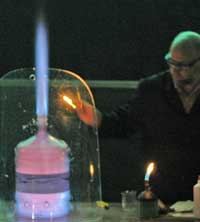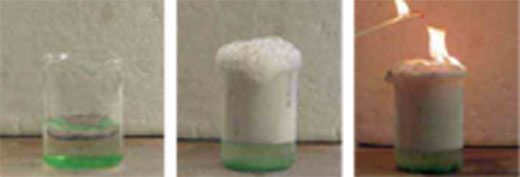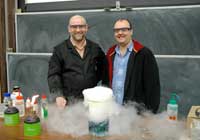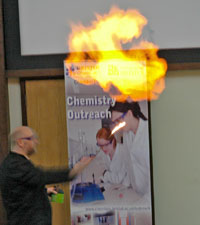Practical demonstrations to augment climate change lessons Teach article
Dudley Shallcross and Tim Harrison from Bristol University, UK, illustrate chemistry experiments relevant to climate change.

in a darkened room
Image courtesy of the University
of Bristol
There are a number of chemicals that are important to consider for climate change, either as contributors to global warming (soot and carbon dioxide) or as alternative fuels (methanol and hydrogen). In the second of two articles (see also Shallcross & Harrison, 2008), we present several classroom demonstrations and experiments to introduce these materials and describe how they can be used to enliven climate change lessons.
Safety note:
Local rules and regulations on health and safety should be applied before trying these out. Always practice the experiments before presenting them in front of students.
Soot / particulate carbon
Soot fits into the category of airborne particulate matterw1. Particles are considered hazardous when they are less than five micrometres in diameter, as they are not filtered out by the upper respiratory tract before entering the lungs.
Black carbon will enhance global warming, but not all particles in the atmosphere do. It all depends on their optical properties: if the particles are very reflective, like a mirror (e.g. sea-salt particles), they can reflect incoming solar radiation back to space and decrease the radiation that reaches Earth, causing a reduction in surface temperature. If they are dark, such as soot, they will absorb incoming radiation and enhance warming.
Soot is a product of incomplete combustion, for example in car motors, central heating or power stations. There are a number of reactions that can produce soot. The simplest teacher demonstration is to burn small pieces of expanded polystyrene packaging, holding them with tongs over a heatproof mat. The yellow flame produced is very smoky, and the smoke contains black specks of carbon. However, this is not a suitable reaction for students to perform, as the polystyrene drips molten droplets of burning material; instead, the teacher should demonstrate.
If a class experiment to produce soot is needed, the combustion of freshly prepared acetylene (ethyne, C2H2) gas is an entertaining reaction. Take a 250 ml glass beaker, place it on a heatproof mat and half fill the beaker with water. Add a good squirt of washing-up liquid to the water and also a few pieces of calcium carbide (CaC2). The reaction is immediate, liberating bubbles of acetylene. The teacher or student can then use a lit splint, taper or match to ignite the foam. This burns dramatically with a yellow flame with smuts of carbon (see images below).

Images courtesy of Tim Harrison
Safety notes:
As with all experiments, safety glasses must be worn.
If the beaker is over-filled or too much calcium carbide is used, the bubbles can overflow onto the heatproof mat. These bubbles can also combust! Bubbles may continue to be ignited by others burning near them. This may go on for 30 seconds or so. Leave any used beaker in a fume cupboard until all the ethyne gas has been produced and the bubbling stops.
The residual solution is mainly alkaline calcium hydroxide solution.
Solubility of CO2 in water / precipitation of calcium carbonate

Shallcross with dry ice reacting
in alkaline water
Image courtesy of the University
of Bristol
If dry ice is available, an interesting experiment can be performed to demonstrate the solubility of carbon dioxide in water. This can be used to introduce a discussion about the uptake of carbon dioxide (CO2) by the oceans as a possible mechanism for removing carbon dioxide from the atmosphere. For this very visually impressive reaction, add a handful of dry ice (take care to avoid cold temperature burns) to a large (1 l) beaker of water that has been made alkaline (pH = ~12) with sodium hydroxide (NaOH) solution, and to which a small volume of universal (pH) indicator has been added.
Apart from the impressive condensation of water vapour, forming a cloud above the beaker, the formation of carbonic acid (a weak acid) causes a series of colour changes to the indicator from purple through to orange . For a more impressive cloud, use hot water, as there is more water vapour to condense. The condensation is caused by very cold carbon dioxide gas produced when the dry ice sublimes, using energy from the much hotter water. Some of the carbon dioxide dissolves in the water.
CO2(g) + H2O(l)→ H2CO3(aq)
The carbonic acid formed neutralises the sodium hydroxide, forming sodium hydrogen carbonate.
H2CO3(aq) + NaOH(aq) → NaHCO3(aq) + H2O(l)
H2CO3(aq) ⇌ H+(aq) + HCO3–(aq)
Excess H2CO3(aq) is acidic because it dissociates in water, releasing hydrogen ions.
A small piece of dry ice placed in lime water (calcium hydroxide solution, Ca(OH)2(aq)) can also be used to show the precipitation of carbon dioxide as calcium carbonate. The oceans of the world dissolve carbon dioxide gas and can precipitate calcium carbonate, which is used in shell construction by numerous creatures. The rate of dissolution is too slow to compensate for the increase in atmospheric carbon dioxide:
Ca(OH)2(aq) + CO2(g) → CaCO3(s) + H2O(l)
If no dry ice is available, then a 2 l drinks bottle could be filled with carbon dioxide gas and about 30 cm3 of 2 mol dm-3 sodium hydroxide can be added. Place the top on the bottle and shake. The bottle should start to collapse as the carbon dioxide gas reacts with the sodium hydroxide, thus reducing the pressure inside the bottle. The solution forms exothermically so that it gets warm. This shows that carbon dioxide gas is acidic. This has implications for the change in the ocean’s pH as the high concentrations dissolve over time.
NaOH(aq) + CO2(g) → NaHCO3(aq)
Safety notes:
Lime water (calcium hydroxide solution) is an alkaline solution, as is sodium hydroxide solution; safety glasses must be worn.
Dry ice (solid carbon dioxide) is -78 ºC or less and will cause cold burns. Great care must be exercised in handling the solid. The use of suitable gloves is recommended. Dry ice should not be kept in a screw-top container because of the risk of explosion.
Methanol whoosh bottle
Methanol is a biofuel, an alternative to fossil or nuclear fuels, and this experiment can be used to demonstrate its combustion. In addition to being a renewable fuel, methanol has the advantage over fossil fuels of not releasing ‘stored’ carbon dioxide into the atmosphere; instead, it merely recycles carbon dioxide that is in the environment anyway.
Methanol vapour (which is toxic) can be ignited inside an 18 l plastic water bottle of the type used in water dispensers. Note that after the experiment, the container will no longer be fit for its original purpose!
Pour around 20 ml of methanol (methyl alcohol, CH3OH) into a dry 18 l water canister and shake to vaporise. Pour out the surplus liquid methanol. In a warm room, you will be able to feel the pressure of the vapour if you hold your hand over the bottle mouth. Put the bottle behind a transparent safety screen on the floor and away from any overhead heat, flame, flash sensors or curtains. Put a lighted taper or match to the mouth of the water bottle, holding it at arm’s length. A blue flame will erupt with a loud roar as the methanol completely combusts.
Safety notes:
Avoid methanol coming directly into contact with your skin, as it is toxic. Any liquid methanol must be poured out of the container away from any flame source.
The water canister cannot subsequently be used for drinkable water.
The water bottle must be dry, as the tops of wet bottles tend to melt during the combustion!
2CH3OH(g) + 3O2(g) → 2CO2(g) + 4H2O(l)
Hydrogen-filled balloons

Image courtesy of the University
of Bristol
This teacher demonstration could be used to introduce hydrogen as an alternative fuel to replace fossil fuels, and especially to raise the question of whether the combustion product is a greenhouse gas.
One way to demonstrate that hydrogen is a fuel is to fill a balloon with hydrogen and tether it to a chair placed away from sensors and flammable materials (such as posters, blinds or curtains) using a piece of thin string. Ignite the balloon using a lit taper or match, fastened to the end of a metre ruler or a long pole at arm’s length. Students should remain several metres away, as, during the resultant explosion, bits of the rubber balloon tend to fly in all directions. Those with sensitive hearing should place their hands over their ears. The flame and heat energy liberated are spectacular and should lead to discussion of hydrogen’s suitability as a fuel.
2H2(g) + O2(g) → 2H2O(g)
Safety note:
If in any doubt about the volume of flame produced, perform the experiment outside and away from glass windows.
The reduction of iron oxide on a match head
The use of blast furnaces in the iron and steel industries contributes to the atmospheric concentration of carbon dioxide. The crucial reaction, which reduces iron oxide to pure iron by means of carbon monoxide, is:
Fe2O3(aq) + 3CO(g) → 2Fe(s) + 3CO2(g)
Students can mimic this reaction on the head of a match.
Moisten an unlit match with water and roll into sodium carbonate (Na2CO3) powder, and then in iron oxide powder (Fe2O3), so that both stick to the match head. Use a second match to ignite the first and let it burn for a moment or two. Crunch the first match head onto a watch glass or Petri dish. Drag a magnet against the underside of the watch glass; the small particles of iron formed will be visible as they follow the magnet’s pull. Try this with the starting materials, to show that no magnetic materials were initially present.
The match provides both the energy for the reaction and the carbon monoxide as a reducing agent. The sodium carbonate acts as a flux material.
Safety note:
Spilled iron oxide or sodium carbonate powders should be wiped up with a cloth. Do not blow them away, as – like any other fine powder – they pose a respiratory hazard.
Students, unless warned, could burn themselves on the hot match heads!
Further experiments
Other experiments that can be performed as part of a project about climate change include:
- The use of Grätzel cells to show the generation of electricity from sunlight, using the colorant molecules in materials such a blackcurrants
- The use of alcohol burners to determine the energy stored in simple alcohols
- The preparation of biodiesel from vegetable oils
- The generation of electricity from alcohols using a fuel cell
References
- Shallcross D, Harrison T (2008) Climate change modelling in the classroom. Science in School 9: 28-33.
Web References
- w1 – For more information about particulate matter, see the Wikipedia page: http://en.wikipedia.org/wiki/Particulate
- w2 – Why not discuss how to teach climate change with other teachers across Europe? Join the Science in School online discussion forum.
Resources
- Harrison T, Shallcross D, Henshaw S (2006) Detecting CO2 – the hunt for greenhouse-gas emissions. Chemistry Review 15: 27-30
- Johnson S (2008) Planting ideas: climate-change activities for primary school. Science in School 10: 55-63 www.scienceinschool.org/2008/issue10/psiclimate
- Pacala S, Socolow R (2004) Stabilisation wedges: solving the climate problem for the next 50 years with current technologies. Science 305: 968-972. doi: 10.1126/science.1100103
- Shallcross D (2006) Dirty Air. Education in Chemistry, Sep. www.rsc.org/Education/EiC/Restricted/2006/Sept/DirtyAir.asp
- For a full list of Science in School articles about climate change, see: www.scienceinschool.org/climatechange
- Numerous notes on air pollution, climate change and ozone depletion notes for schoolteachers by the authors can be found online at: www.chemlabs.bristol.ac.uk/outreach/resources/Atmos.html
- An excellent source of graphics and data relating to climate change can be found on the website of the GRID-Arendal collaborating centre of the United Nations Environment Programme: www.grida.no/climate/vital/index.htm
- For data from the Earth Station research laboratory Global Monitoring Station, see: www.cmdl.noaa.gov
- The website of the Intergovernmental Panel on Climate Change, which includes the Climate Change 2007 report and other data, can be found here: www.ipcc.ch
Review
Climate change should certainly be one of the topics of today’s science teaching at all school levels throughout Europe. Particularly after Al Gore’s documentary, An Inconvenient Truth, the topic has gained worldwide recognition. Useful materials with usable background information for science teachers, though, are not always readily available. However, this article – the second of two – offers some dramatic and enjoyable demonstrations.
If further articles follow, there is the chance of starting a European-wide discussion on how best to implement the topic of climate change and global warming in European science classes.
Tobias Kirschbaum, Germany





